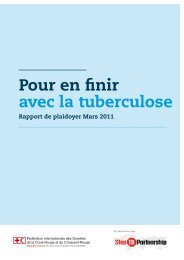Thailand - Stop TB Partnership
Thailand - Stop TB Partnership
Thailand - Stop TB Partnership
Create successful ePaper yourself
Turn your PDF publications into a flip-book with our unique Google optimized e-Paper software.
The hidden costs of treatment<br />
It is true that we receive free diagnosis and treatment, but [<strong>TB</strong>] drugs are<br />
very powerful, and they need to be taken with sufficient food. A majority of<br />
us [patients] are from poor families and we have only one meal per day.<br />
So sometimes we are forced to skip the drugs.<br />
—<strong>TB</strong> patient, Dar es Salaam, Tanzania 40<br />
Adhering to the six-month <strong>TB</strong> treatment regimen is a challenge, particularly for patients<br />
who are malnourished, taking antiretroviral drugs, grappling with other illnesses, or poor.<br />
Strict compliance with treatment requires a serious investment of patients’ time, energy, and<br />
household resources. Reports from all five countries revealed that even though <strong>TB</strong> treatment<br />
is free, patients are often confronted with significant “hidden costs,” including outlays for<br />
diagnostic tests, transportation to health facilities, nutritional supplements (since patients<br />
require an adequate diet to take their medications), and time away from work. In Tanzania,<br />
patients from rural areas in particular may spend several hours traveling to and from health<br />
facilities and one to six hours in the clinic waiting to receive medications—every day for<br />
the first two months of treatment. Similarly, in Nigeria, research revealed that states in the<br />
north, which are typically poorer, have far fewer <strong>TB</strong> centers available per capita, meaning<br />
that patients have to travel much farther for treatment. For example, as of January 2005,<br />
Zamfara State in the north had only 10 DOTS centers for a population of 3.6 million people,<br />
while Ogun State in the south had 116 DOTS centers for 2.3 million people. 41 For many<br />
patients, who also have to think about earning a livelihood and familial responsibilities,<br />
traveling such a long distance for <strong>TB</strong> care is simply untenable.<br />
Yet despite the clear connection between <strong>TB</strong> and socioeconomic factors, governments<br />
continue to deal with the disease primarily as a public health problem rather than<br />
as a broader development issue. <strong>TB</strong> is usually left to the “experts,” a small circle of medical<br />
and health professionals working within or connected to the Ministry of Health. For<br />
example, while maternal and child health, infant mortality, and HIV/AIDS are highlighted<br />
in Thai poverty reduction schemes, <strong>TB</strong> is not mentioned. The Brazilian government has<br />
long acknowledged that providing “incentives” such as nutritional supplements and transportation<br />
subsidies to <strong>TB</strong> patients is necessary to ensure treatment adherence. Yet under<br />
Brazil’s decentralized system, individual states and municipalities have the responsibility<br />
to budget for the incentives, and thus their availability in practice varies greatly from state<br />
to state and within states.<br />
Patterns of <strong>TB</strong> prevalence and the crippling hidden costs of treatment may<br />
help to explain why there has not been more civil society involvement around <strong>TB</strong>. People<br />
living in poverty, women, and members of other vulnerable groups are not generally well<br />
PUBLIC HEALTH WATCH MONITORING REPORTS 21



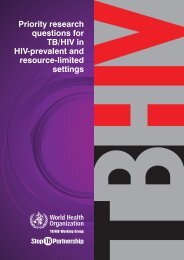
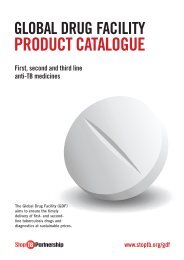
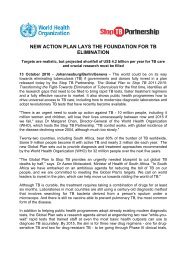
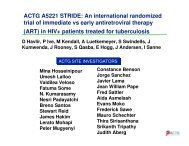
![Global Drug Facility Annual Report 2011 [.pdf] - Stop TB Partnership](https://img.yumpu.com/26788745/1/184x260/global-drug-facility-annual-report-2011-pdf-stop-tb-partnership.jpg?quality=85)

![Concept note on national stop TB partnership [.pdf]](https://img.yumpu.com/26788741/1/184x260/concept-note-on-national-stop-tb-partnership-pdf.jpg?quality=85)
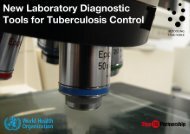

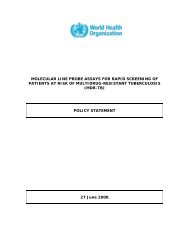
![2005 and Challenges for 2006 - 2015 [.pdf] - Stop TB Partnership](https://img.yumpu.com/26788674/1/190x245/2005-and-challenges-for-2006-2015-pdf-stop-tb-partnership.jpg?quality=85)
![Brochure (French) [.pdf] - Stop TB Partnership](https://img.yumpu.com/17234792/1/190x91/brochure-french-pdf-stop-tb-partnership.jpg?quality=85)

